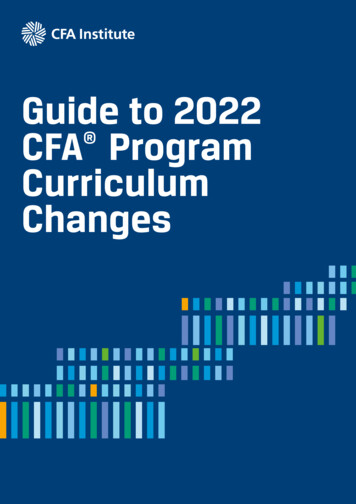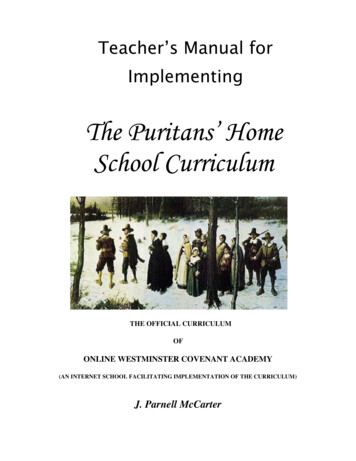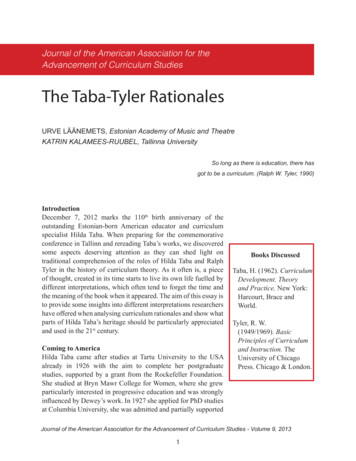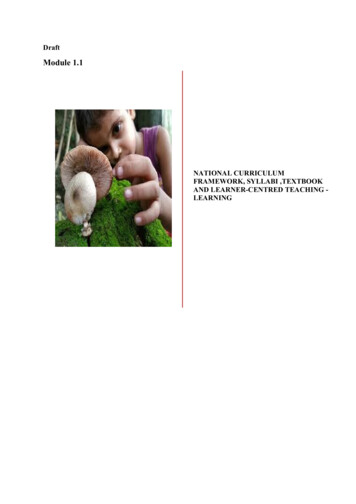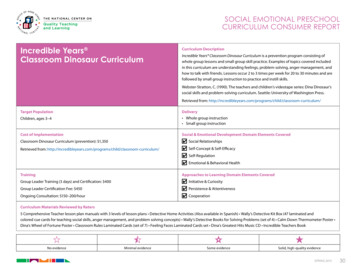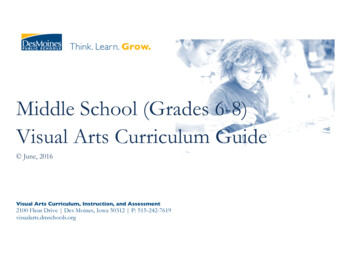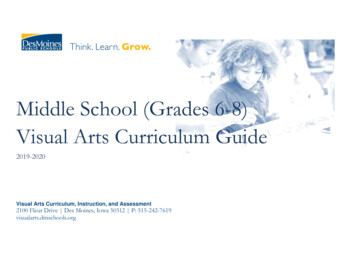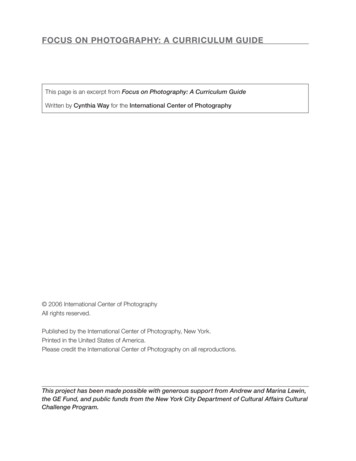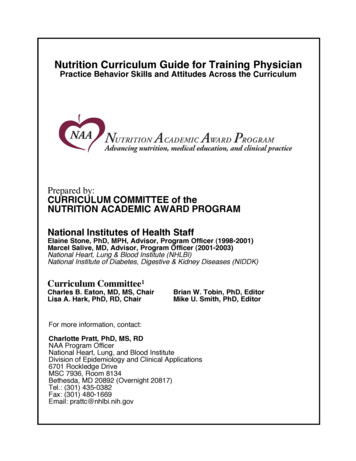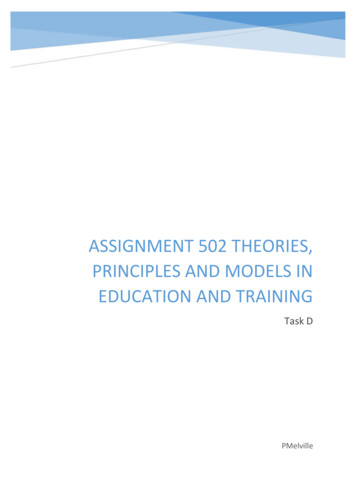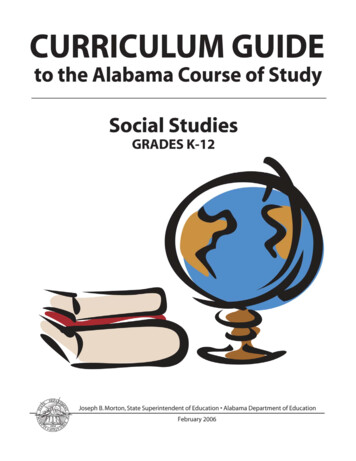
Transcription
CURRICULUM GUIDEto the Alabama Course of StudySocial StudiesGRADES K-12- .,,1Joseph B. Morton, State Superint endent of Education Alabama Department of EducationFebruary 2006
For information regarding the Curriculum Guide to the Alabama Course of Study: Social Studies,contact Special Education Services, Alabama Department of Education, 3345 Gordon Persons Building,50 North Ripley Street, Montgomery, Alabama 36104,or by mail to P.O. Box 302101, Montgomery, Alabama 36130-2101.Telephone number (334) 242-81142006Joseph B. Morton, State Superintendent of EducationAlabama Department of EducationNo person shall be denied employment, be excluded from participation in, be denied the benefits of, or be subjected to discrimination in any program oractivity on the basis of disability, sex, race, religion, national origin, color, or age. Ref: Sec. 1983, Civil Rights Act, 42 U.S.C.; Title VI and VII, CivilRights Act of 1964; Rehabilitation Act of 1973, Sec. 504; Age Discrimination in Employment Act; Equal Pay Act of 1963; Title IX of the EducationAmendment of 1972: Title IX Coordinator, P.O. Box 302101, Montgomery, Alabama 36130-2101 or call (334) 242-8444.
Curriculum Guideto theAlabama Course of Study: Social StudiesT a b l eo fC o n t e n t sACKNOWLEDGMENTS .iiINTRODUCTION.1ORGANIZATION OF THE CURRICULUM GUIDE .2HOW CAN TEACHERS MOST EFFECTIVELY USE THIS DOCUMENT?.3SOCIAL STUDIES STANDARDS AND INSTRUCTIONAL OBJECTIVESKindergarten – Self and Family .4First Grade – Exploring Our Community and State .8Second Grade – Exploring Our Nation and World: People and Places .12Third Grade – People, Places, and Regions: Geographic Studies .16Fourth Grade – Alabama Studies .22Fifth Grade – United States Studies: Beginnings to 1877 .31Sixth Grade – United States Studies: 1877 to the Present .37Seventh GradeCitizenship .45Geography .50Eighth Grade – World History to 1500 .55Ninth Grade – World History: 1500 to the Present .62Tenth Grade – United States History to 1877 .70Eleventh Grade – United States History: 1877 to the Present .76Twelfth GradeEconomics .88United States Government .95APPENDIX A. Alabama Occupational Diploma (AOD)Social Studies Course Requirements for High School.103APPENDIX B. Alabama High School Graduation ExamSocial Studies Standards and Objectives .105APPENDIX C. Reading Skills for Social Studies .107APPENDIX D. Graphic Organizers for Social Studies .111APPENDIX E. Web Sites for Social Studies Teachers and Students .117BIBLIOGRAPHY .125GLOSSARY.127i
AcknowledgmentsThis document was developed by the 2004 Social Studies Curriculum Guide Task Force. Task Forcemembers included special and general education teachers, coordinators, parents of children withdisabilities, and representatives of parent advocacy groups.SOCIAL STUDIES CURRICULUM GUIDE TASK FORCEChuck Alford, Social Studies Teacher, Crenshaw County Board of EducationDanny Alverson, Social Studies Teacher, Shelby County Board of EducationAmanda Anderson, Special Education Teacher, Chilton County Board of EducationSharon Blythe, Special Education Transition Specialist, Talladega County Board of EducationFran Cox, Social Studies Teacher, Demopolis City Board of EducationWendy Dean, Outreach Coordinator, Special Education Action Committee (SEAC), MontgomeryChristi Gaither, Social Studies Teacher, Calhoun County Board of EducationEllen Harner, Special Education Teacher, Calhoun County Board of EducationShannon Hess, Special Education Program Specialist, Shelby County Board of EducationTammy Knott, Special Education Teacher, Demopolis City Board of EducationRhonda Lassiter, Special Education Teacher, Houston County Board of EducationRandall Meadows, Jr., Social Studies Teacher, Houston County Board of EducationRandy Wilkes, Special Education Coordinator, Crenshaw County Board of EducationState Department of Education personnel who provided leadership during the development of thedocument were:Joseph B. Morton, Ph.D., State Superintendent of Education; andFeagin Johnson, Jr., Assistant State Superintendent of Education.State Department of Education personnel who managed the development process were:Mabrey Whetstone, Ph. D., Director, Special Education Services;DaLee Chambers, Ph. D., Education Specialist, Special Education Services;Susan Cunningham, Education Consultant, Special Education Services;Cheryl Holder, Ed. D., Education Consultant, Special Education Services;Marla D. Holbrook, Administrator, Special Education Services;Tuwanna McGee, Education Specialist, Special Education Services;Charlie Jackson, Education Specialist, Special Education Services; andDan Roth, Education Specialist, Special Education Services.The State Department of Education program specialist who assisted the Task Force in reviewing thedocument was:Susan DuBose, Social Studies Specialist, Field Services, Classroom Improvement.Ray Glasscock, clerical support staff, Special Education Services, assisted with the preparation ofthe document.Susan J. Blankenship, (retired) Education Specialist, State Department of Education, edited andproofread the document.ii
IntroductionThe 2005 Curriculum Guide to the Alabama Course of Study: Social Studies is a companiondocument to the Grades K-12 Alabama Course of Study: Social Studies (Bulletin 2004, No. 18). TheAlabama Course of Study: Social Studies was developed by members of the Social Studies StateCourse of Study Committee and Task Force and was adopted by the Alabama State Board ofEducation in April 2005. These standards can be accessed from the Alabama Department ofEducation Web site at www.alsde.edu. On the home page, select Sections and then ClassroomImprovement. Click on Publications, scroll down to Courses of Study and click on Social Studies.Educators are reminded that content standards indicate minimum content—what all students shouldknow and be able to do by the end of each grade or course. Local school systems may haveadditional instructional or achievement expectations and may provide instructional guidelines thataddress content sequence, review, and remediation.The Curriculum Guide to the Alabama Course of Study: Social Studies prepares students for studyof grade-level content standards through the teaching of prerequisite and enabling skills necessaryfor learning each content standard. This allows students to work toward grade-level standards whileworking at individual ability levels. By identifying the prerequisites and enabling skills for eachstandard, teachers may plan instruction to address the achievement gap experienced by somestudents while still working with all students toward achievement of the same standards. Some usesof the guide include, but are not limited to, the following: (1) lesson planning, (2) Building-BasedStudent Support Team (BBSST) considerations, (3) Individual Educational Program (IEP)development, (4) collaborative teaching, (5) tutorials, (6) planning for instructional groupings, (7)parent information and conferences, (8) development of curriculum-based assessments, and (9)preparation for state assessments.1
Organization of the Curriculum GuideThe organizational components of this guide include standards, instructional objectives, examples,and bullets. Content standards are statements that define what all students should know and beable to do at the conclusion of a course or grade. Content standards contain minimum requiredcontent and complete the phrase “Students will.”Content standards for a grade level or course should be clearly written, reasonable, measurable,developmentally appropriate, and sufficiently rigorous to enable Alabama students to achieve atlevels comparable to other students in the nation and the world. They should also provideproportional emphasis to the essential knowledge, skills, and processes of a given grade level orcourse.Bullets denote content that is related to the standards and required for instruction. Bulleted contentis listed under a standard.Examples clarify certain components of content standards or bullets. They are illustrative but notexhaustive. Examples are not part of the minimum required content.Instructional objectives divide the standards into smaller instructional units that serve asfoundational skills for the standards. Instructional objectives are useful in lesson planning,classroom instruction, and IEP development. Utilization of instructional objectives facilitates havingall students working toward grade-level standards while also working at individual ability levels.Instructional objectives preceded by a diamond shape ( ) indicate content required for earningGrades 9 – 12 course credit for the Alabama Occupational Diploma (AOD).Instructional objectives within this document are numbered according to grade level, contentstandard number, and the order in which the instructional objective is listed. The system fornumbering instructional objective 1.5.1., for example, is based upon the following:Grade levelContent standard numberObjective - -Objective 1. 5. 1: Tell the difference between human-made and natural resources.In addition, the numbering system in this document for seventh- and twelfth-grade instructionalobjectives contains a letter immediately after the grade-level to indicate citizenship (C) orgeography (G) content in Grade 7 and economics (E) or United States government (G) content inGrade 12. In seventh grade, for example, the “C” in instructional objective 7C.3.1. indicatescitizenship content; while in twelfth grade, the “G” in instructional objective 12G.7.2. reflectsUnited States government content.Grids to the left of each content standard indicate the dominant strands that are addressed in thestandard or related content found in the bullets—economics (E), geography (G), history (H), orindicates content related to Alabama history andpolitical science (PS). The Alabama map icongeography.u2
How Can Teachers Most Effectively Use This Document? Become familiar with the Alabama Course of Study: Social Studies (Bulletin 2004, No. 18). Review the supporting 2005 Curriculum Guide to the Alabama Course of Study: Social Studiesfor Grades K – 12. Correlate standards and instructional objectives in the guide with the Compendium Supplementfor the Stanford Achievement Test, 10th Edition. Correlate the standards and instructional objectives in the guide with the Item Specifications forSocial Studies for the Alabama High School Graduation Exam. Use the guide and correlations for instructional planning. Teach all content specified in courses of study for each grade level or course. Emphasize the importance of vocabulary in all content areas. Connect students’ prior knowledge to social studies concepts. Develop curriculum-based assessments based on the standards. Make content relevant to real life situations. Use the instructional objectives followed by a diamond-shape ( ) as the required course contentfor earning Grades 9 – 12 course credit for the AOD. Emphasize the importance of collaborative teaching and planning between general and specialeducation faculty. Plan and implement activities that address all learning styles—auditory, visual, kinesthetic, andtactile. Provide opportunities for cooperative learning. Use graphic organizers and timelines when teaching social studies. Include hands-on and other active learning experiences to increase student understanding. Provide guided and independent practice.3
GGGH9H9H9Students will:EE9E4PSPSPSKINDERGARTENSelf and Family1. Use daily schedules and timelines from birth to present to relate selfand family to changes over time.Objective K.1.1:Relate pictorially, orally, or in writing importantevents in one’s life and family over time.Objective K.1.2:Identify activities that occur on specific days of theweek on a weekly or monthly calendar.Examples: today—soccer practice, tomorrow—art classAdditional content to be taught: Using vocabulary to describe periods of timeExamples: long ago, yesterday, today, tomorrow2. Compare families of today with families of the past in relation towork, home, and school.Examples:present—one or both parents working outside thehome, families sharing household responsibilities,students having choices of transportation;past—parents working together on family-ownedfarms, family responsibilities assigned by gender,students walking to schoolObjective K.2.1:Compare pictures of families of today to pictures offamilies of the past.Objective K.2.2:Describe what life was like during the childhood ofa family member based on information gained from an interview.Veterans Day, Independence Day3. Identify historically significant events as they relate to self andfamily.Examples:Objective K.3.1:Tell about an important event that relates to self andfamily.Objective K.3.2:Draw a picture illustrating family activitiesassociated with celebrating a holiday.Additional content to be taught: Identifying famous individuals associated with holidays andcelebrationsExamples: Presidents’ Day—George Washington, AbrahamLincoln;Thanksgiving—Squanto, Pilgrims;Black History Month—Rosa Parks, Martin LutherKing, Jr., Booker T. Washington Describing personal and family experiences related to holidays andcelebrationsD
KEGHPSI9 I I I 9 I4. Identify personal use of goods and services.Objective K.4.1:Objective K.4.2:your family.Identify ways to use money.Identify ways community helpers can assist you andAdditional content to be taught: Demonstrating ways money is used in everyday lifeExamples: saving money in piggy banks, using money to buypencils at the school supply store Identifying various community helpers and their roles in thecommunityExamples: farmers providing food, firefighters putting outfires, health care professionals giving vaccinations,police officers protecting citizensE9GHPSI I I I I5. Identify personal wants and needs.Objective K.5.1:Compare personal wants with personal needs.Examples: wanting a toy, needing a pencil for schoolAdditional content to be taught: Discussing differences between purchasing and bartering formaterialsExamples: purchasing candy at the grocery store, tradingcandy for baseball cards Discussing reasons for making choicesEG9HPSI I I I I6. Identify vocabulary related to location and direction.Objective K.6.1:Example:Objective K.6.2:Demonstrate the ability to follow directions.playing the game “Simon Says”Use appropriate direction words in a sentence.Additional content to be taught: Locating objects and places to the right or left, up or down, in orout, and above or below Giving directions Following directions5
KEG9HPSI I I I I7. Identify representations of Earth using technology, maps, and globes.Objective K.7.1:Differentiate between land mass and water on acomputer, map, or globe.Additional content to be taught: Creating simple mapsExamples: home, classroom, schoolE9G9HPSI I I I I8. Describe effects of different seasons on self and family.Example:needing to wear a coat in winterObjective K.8.1:Name the four seasons of the year, including theweather conditions associated with each season.Objective K.8.2:Describe recreational activities associated with eachseason of the year.Additional content to be taught: Discussing economic factors impacted by seasonal changesExample: heating and cooling expensesEGHPSI I9 I9 I I9. Describe ways people celebrate their diverse cultural heritages.Examples: literature, language, games, songs, dances, holidaysObjective K.9.1:your family.EGHPS9I I I I ITell about a special day or holiday celebrated with10. Discuss rights and responsibilities of individuals in relation todifferent social groups, including family, peer group, and classmates.Objective K.10.1:Describe responsibilities at home and at school.Examples: home—putting away toys,school—cleaning erasersObjective K.10.2:Explain ways others help at home and school.Examples: home—sister babysitting new baby,school—classmate watering plantsAdditional content to be taught: Explaining the importance of manners and social etiquette Explaining the necessity for rules and laws and consequences offailing to obey themExamples: raising hand before speaking to eliminate noise andallow every person to be heard, obeying trafficsigns and signals to avoid traffic tickets andaccidents, recognizing that playing with matchescould lead to getting burned6
EGH9PS911. Identify historic symbols of patriotism.Examples: Alabama state flag; the flag of the United States; eagle;Pledge of Allegiance; red, white, and blue; the song“America”; the national anthem “The Star-SpangledBanner”Objective K.11.1:community.Example:7Kstate and United States flags at post office, school,and courthouseLocate common patriotic symbols in the localD
FIRST GRADEExploring Our Community and StateStudents will:EGH9PSI I I I I1. Identify past and present modes of air, land, and watertransportation.Examples:airplane, spacecraft; horse and buggy, subwayObjective 1.1.1:Locate pictures that represent present and pastmodes of transportation.Additional content to be taught: Identifying past and present forms of communicationExamples: past—letter, radio, rotary-dial telephone;present—e-mail, television, cellular telephone Identifying past and present types of apparel Identifying past and present types of technologyExamples: past—record players, typewriters, conventionalovens;present—CD and DVD players, VCRs, computers,microwave ovens Identifying past and present types of recreationExamples: past—marbles, hopscotch, jump rope;present—video games, computer games Identifying primary documents of the past and presentExamples: past—letters, newspapers;present—e-mail, Internet articlesEGH9PSI I I I I2. Describe how primary sources serve as historical records of familiesand communities.Examples:oral histories, vacation pictures in scrapbooks, videos,timelinesObjective 1.2.1:Tell about the personal history of a family orcommunity member based on information gained from an interview.Objective 1.2.2:Describe, using a family picture, the role of aperson in your family.8
EG9GG9H9HHHPSPSPSPSExamples:1stMardi Gras, Helen Keller Day, National Shrimp Festival,Boll Weevil FestivalDraw a picture illustrating a historical event inDescribe a historical event celebrated in your townObjective 1.6.1:Describe maps and globes as representations ofphysical features of Earth.Objective 1.6.2:Locate land masses and bodies of water on a mapand on a globe.Additional content to be taught: Explaining uses of cardinal directions on the compass rose Measuring distances using nonstandard meansExample: measuring with pencils, strings, hands, or feet9using money to purchase goods such as groceries, usingmoney to pay for services such as babysittingDefine human-made resources and naturalhuman-made—plastic, rayon;natural—cotton, coal, trees5. Label human-made and natural resources in Alabama.Additional content to be taught: Explaining differences between wants and needs Explaining concepts of saving and borrowing Explaining differences between buyers and sellersObjective 1.4.1:Identify personal wants and needs.Objective 1.4.2:Identify ways to earn money for purchasing itemsbased on one’s wants and needs.Examples:4. Describe the role of money in everyday life.Objective 1.3.1:Alabama.Objective 1.3.2:or community.Examples:3. Identify historical events and celebrations in communities and citiesthroughout Alabama.D6. Identify land masses, bodies of water, and other physical features ofEarth on maps and globes.Objective 1.5.1:resources.DE9E9EG9D
1stEG9HPS9I I I I I7. Identify ways to take personal action to protect the environment.Examples:cleaning up litter, recycling, participating in Earth Dayand Arbor Day activitiesIdentify reasons for the importance of protecting theObjective 1.7.1:environment.E9G9HPSI I I I I8. Identify how occupational and recreational opportunities in Alabamaand local communities are impacted by the physicalenvironment.DExamples:occupational—jobs provided by shrimping industry incoastal communities;recreational—swimming at the beach, hiking in themountainsObjective 1.8.1:Describe job opportunities and recreationalopportunities in the community as related to the physical environment.EG9H9PSI I I I I9. Identify traditions of a variety of cultures in Alabama and localcommunities.DExamples:marriage customs, religious celebrationsObjective 1.9.1:Describe ways people celebrate their diversecultural heritages.Additional content to be taught: Identifying common and unique characteristics of individuals insocietal groups, including age, religious beliefs, ethnicity,disability, and genderEGHPS9I I I I I10. Discuss civic responsibilities of participating members of acommunity and state.Examples:paying taxes, votingObjective 1.10.1:Discuss the rights and responsibilities of individualsin relation to different social groups, including family, peer group, andclassmates.Additional content to be taught: Discussing the meaning of patriotism10
1stEGHPS9I I I I I11. Identify roles and responsibilities of leaders within the communityand state.Examples:recognizing the mayor as city leader, recognizing thegovernor as state government leaderObjective 1.11.1:Identify leaders in the local community.Examples: mayor, city council members, chief of policeObjective 1.11.2:Identify leaders in state government.Examples: governor, attorney generalAdditional content to be taught: Recognizing how laws protect rights and property Identifying reasons for having rules at home and at school11
PSPSPSPSSECOND GRADEExamples:3. Discuss historical and current events within the state and the nationthat are recorded in a variety of resources.Objective 2.2.1:Describe what it means to overcome difficulties orobstacles.Objective 2.2.2:Identify an individual who has overcomedifficulties or obstacles.Examples:Abraham Lincoln rising from poverty and achievingposition of President of the United States, HeatherWhitestone coping with hearing loss and achieving title ofMiss America, Nat “King” Cole struggling withsegregation and becoming a world-renowned singer,Arthur George (A. G.) Gaston overcoming lack ofcompletion of high school education and becomingexceptional businessman and developer and owner of oneof the largest African-American businesses in the UnitedStates, Nelson Mandela confronting apartheid andreceiving the Nobel Peace Prize2. Identify past and present contributions of a variety of individualswho have overcome difficulties or obstacles to achieve goals.Additional content to be taught: Using vocabulary to describe segments of timeExamples: year, decade, centuryObjective 2.1.1:Compare families of today with families of the pastin relation to work, home, and school.past—shopping in general stores, attending frontierschools in one-room buildings;present—shopping in national chain superstores,attending contemporary schools with multipleclassrooms1. Compare features of modern-day living to those of the past.Exploring Our Nation and World: People and PlacesH9H9H9H9Students will:GGGGDEEEE12Objective 2.3.1:List ways to document historical and current events.4. Discuss celebrations in the United States and around the world.Examples:interviews with grandparents, Martin Luther King, Jr.’s“I Have a Dream” speech, video of Neil Armstrong’s walk on the moon,newspaper reports of current elections, video aboutSheyann Webb and her involvement in Selma’s votingrightsD
2ndExamples:Children’s Day in Japan, Veterans Day in the UnitedStates, Bastille Day in France, Cinco de Mayo in Mexico,New Year celebrations in ChinaObjective 2.4.1:Identify celebrations in which your familyparticipates.Objective 2.4.2:Identify celebrations in communities and citiesthroughout Alabama.E9GHPSI I I I I5. Explain the relationship between the production and distributionprocesses.Examples:tracing milk supply from production on the farm togrocery stores and to consumers, tracing themanufacturing of technological components in othercountries to consumers in the United StatesObjective 2.5.1:Identify examples of production and distribution.Examples: production —constructing automobiles on plantassembly lines, preparing hamburgers at fastfood restaurants;distribution—shipping via trucking companies,railways, United States Postal ServiceAdditional content to be taught: Discussing the impact of consumer choices and decisionsExample: cost of buying and caring for a pet Making informed decisions about borrowing and savingE91IG9HIPSI6. Identify human-made and natural resources in the world.IExamples:human-made—paper,natural—crude oilObjective 2.6.1:Identify human-made and natural resources inAlabama.Objective 2.6.2:Compare natural resources in Alabama to naturalresources in the United States and in the world.llll13
2ndEG9HPSI I I I I7. Describe ways people throughout the world are impacted by theirgeographic environments.Examples:land use, housing, occupationsObjective 2.7.1:Describe effects of different seasons oncommunities in various geographic environments.Objective 2.7.2:Identify how occupational and recreationalopportunities in Alabama and in local communities are impacted bythe geographic environment.Additional content to be taught: Comparing physical features of regions throughout the worldExample: discussing differences in a desert environment, atropical rainforest, and a polar region Identifying positive and negative ways people affect theenvironmentExamples: positive—restocking fish in lakes, oceans, andrivers; reforesting cleared land;negative—polluting water; throwing trash onroadways; causing erosionEG9HPSI I I I I8. Identify continents, oceans, and the equator using technology, maps,and globes.Objective 2.8.1:globes.Identify land, water, and the equator on maps andAdditional content to be taught: Identifying map elements, including title, legend, and scale Identifying intermediate directions Utilizing key elements on maps and globes to estimate routesExample: using a map scale to estimate the shortest routefrom one state to another or from Birmingham,Alabama, to Athens, Greece14
2ndEGHPS9I I I I I9. Describe rights and responsibilities of citizens of the United States.Examples:rights—voting, freedom of speech;responsibilities—paying taxesObjective 2.9.1:Discuss rights and responsibilities of individuals inrelation to different social groups, including family, peer group, andclassmates.Objective 2.9.2:Discuss civic responsibilities of members of acommunity and of a state.Additional content to be taught: Explaining the voting process and the use of resultsExample: telling how some national and world issues aresettled by voting Identifying acts of patriotism and symbols of the United StatesExamples: acts—reciting the Pledge of Allegiance to theflag, standing during the national anthem;symbols—Statue of Liberty, Liberty Bell Describing responsibilities of state, national, and world leadersEGHPS9I I I I I10. Discuss ways in which people in authority gain the right to direct orcontrol others.Examples:Objective 2.10.1:figures.being an appointed or elected official, being a parent orguardian, being a police officerDescribe how people become leaders or authorityAdditional content to be taught: Describing the appropriate use as well as the misuse of power andauthorityExamples: use—determining safety rules,misuse—showing disrespect for personal freedomsEG9H9PSI I I I I11. Explain how the diversity of people and customs in the United Statesand the world affect viewpoints and ideas.Objective 2.11.1:Identify similarities and differences among culturesand customs represented in the school or classroom.Objective 2.11.2:Describe the relationship between the customs andviewpoints and ideas of diverse persons in the United States.Additional content to be taught: Discussing how and why people from various cultures immigratedto the United StatesExamples: how—ships, planes, automobiles;why—improved quality of life, family connections,agricultural disasters15
H9HPSPSTHIRD GRADEObjective 3.1.1:Identify on a co
Introduction The 2005 Curriculum Guide to the Alabama Course of Study: Social Studies is a companion document to the Grades K-12 Alabama Course of Study: Social Studies (Bulletin 2004, No. 18). The Alabama Course of Study: Social Studies was developed by members of the Social Studies State Course o


